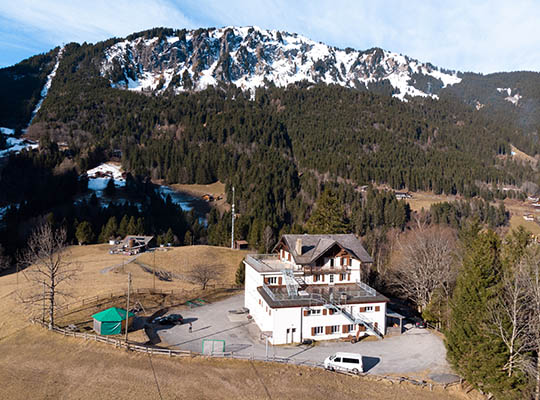The business benefits of 5G
Four specific examples for 5G applications in the business environment
5G is not just quicker. These four specific examples show how a 5G network in commercial use simplifies infrastructures and enables new applications. Examples that are not possible with current technologies.
Text: Andreas Heer, 12
1. Broadband Internet at remote locations
The Chalet Jolimont above Champéry is located in an idyllic landscape, surrounded by the Valais Alps. The group accommodation is best suited as a school and summer camp. However, as is frequently the case in Switzerland, idyllic also means remote and thus moderately accessible.
However, guests of Chalet Jolimont do not have to go without high-performance internet access. Fixed Wireless Access (FWA) connects the holiday complex with the outside world via 5G broadband internet. And it offers enough bandwidth so that the holiday guests can talk to those at home via video telephony and a film can be shown on the final evening via streaming without jerking. Thanks to the bandwidth of 5G, FWA replaces a corresponding cable connection and enables even remote buildings to have up-to-date Internet access.

Fixed Wireless Access (FWA) offers good Internet access even in remote buildings via the 5G network.
2. Television transmission without cable clutter
Sports events are a logistical challenge. Kilometres of cable must be laid temporarily to connect cameras and cameramen to the control room. Timing equipment has to be installed, and communication between the various helpers currently requires radio equipment. For all these devices to communicate smoothly, an elaborate wireless and wired infrastructure is required.
A sports event often lasts only one or a few days. During this time, all material must be transported, assembled and then dismantled on site. The technicians use whole truckloads of material. In addition, this technology is exposed to adverse weather conditions: Wetness, cold and heat put a lot of strain on the material. This particularly affects the cables. Cracks and fractures are the result. Defective cables must be disposed of and replaced properly after the event.
However, there are alternative solutions. As part of the 2020 Winter Youth Olympic Games, Swisscom, together with partners such as the EPFL, HEIG-VD (the University of Applied Sciences of the Canton of Vaud) and the Neuchâtel company NuLink, tested a wireless communication infrastructure for the entire technology in a pilot trial. A local, private 5G network connected cameras, radio equipment, microphones and timing systems, and also the media workstations. The challenge was not only the large amount of data, but also the delay-free transmission of image and sound to the director and editor as well as the exact timing. The infrastructure for the snowboard and skicross competitions in Villars was constructed.
The added value of 5G in broadcasting lies in the simplification of the infrastructure. The costs for transport and assembly are reduced. And if all wireless devices communicate over the same network, there is no need to build different network infrastructures for different applications.
3. Targeted weed control
The company ecoRobotix has developed the weed robot AVO, a device for efficient control of undesirable plants in fields. Thanks to visual and GPS navigation, the four-wheeled, solar-powered device drives independently over a field and detects weeds using image recognition. Subsequently, the robot then sprays the weeds accurately with herbicide. The aim is to reduce its requirements by more than 90%, an ecological and economic measure.
AVO does not currently use 5G. But according to ecoRobotix CEO Aurelien G. Demaurex, the next generation of mobile phones would bring decisive advantages: “Thanks to the better coverage, AVO could directly alert the farmer in the event of special incidents such as plant diseases or nutrient shortages.” The weed robot could directly transmit the recordings and specialists provide the farmers with an assessment. “This would help us in our long-term vision: to develop an autonomous robot that takes care of every single plant in the field,” says Demaurex. The farmers, in turn, would benefit from more efficient management and could increase yields.
4. Autonomous robots and machines in production
In industrial production, many work steps have long since been automated. Robots provide support during production. It is important that the individual processes are coordinated to ensure efficient and high-quality production. Today, industrial robots and machines are usually controlled by different technology standards and do not communicate with each other. This requires a lot of specific knowledge, offers room for error sources and is not very flexible. A uniform 5G connection provides a remedy here. If a Swiss machine manufacturer incorporates 5G into his products, he can be sure that they will work all over the world, no matter where the customer will ultimately use the machine.
At the World Economic Forum (WEF) in Davos, Swisscom, ABB and Ericsson demonstrated what is possible with 5G in the field of autonomous machines. Visitors could write greetings on a tablet, which were drawn in sand by two industrial robots almost in real time. This implementation was synchronous, even though the two “draftsmen” were 1.5 kilometres apart. The low latency of 5G made it possible for the robots to still work synchronously.
In industry, this real-time communication over 5G brings two advantages. On the one hand, machines can be integrated that move autonomously and therefore cannot be wired. On the other hand, wireless networking allows flexible design of factories and assembly lines and fast adaptation – whether the adaptation is done in a factory or machines are moved between locations. Here too, flexibility and simplification are the major advantages of a 5G network.

The low latency of 5G enables robots to work synchronously.
More on the topic:





